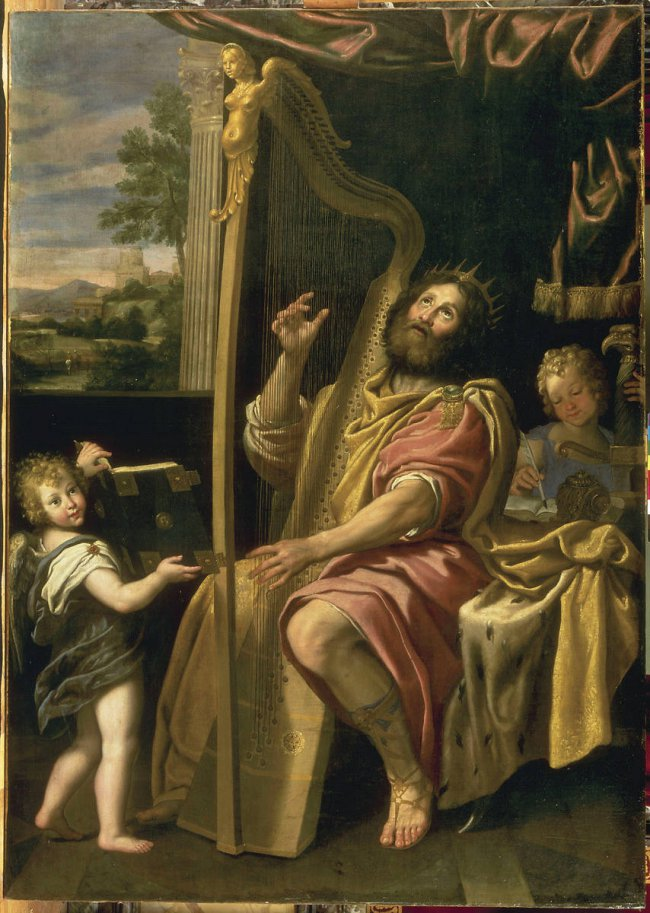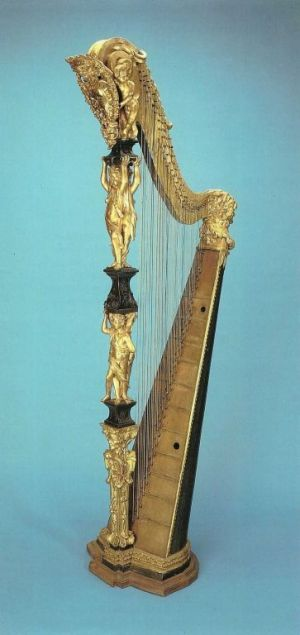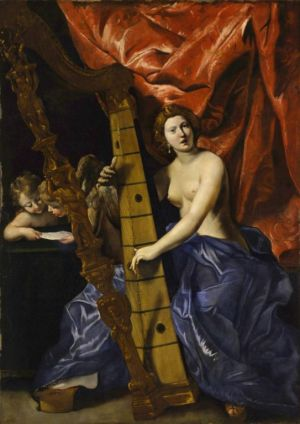2.1 What is this, fundamentally? Original Source Material for the Arpa Doppia
How do we know how the arpa doppia was played? Developing historical technique requires not only disciplined research but a degree of hermeneutic exegesis. The study of primary source material returns us Aurelius’s principle, "What is this, fundamentally? What is its nature and substance, its reason for being? What is it doing in the world?”1 In this way, we can engage with the primary sources as glimpses into broader function and musical practice. This is true not only of surviving instruments themselves but in their representations.
It is logical to look to paintings of contemporary to the arpa doppia for technical insight. In the case of the three coursed arpa doppia, both harp and harpist feature within Zampieri’s David che suona l'arpa and Lanfranco’s Venus tocando el arpa (Alegoría de la Música).
This is in stark opposition to the arpa doppia. (Fig. 2.14) The slight dip and steep soundboard set the default position as the bass, requiring a twisting of the body or shifting back of the shoulder for the high trebles. This bass centred playing is supported by the compositions of Guerieri, which set harp parts on bass staves written to accommodate harp or theorbo.5 6 The closer position of strings facilitate arpeggios quickly across a larger range, ideal for continuo. This is in line with Agostino Agazzari’s classification of the instrument as fondamento.7
The quality of the arpa doppia most predominantly described, in treatises by Agazzari and Marin Mersenne, is the flexibility of the instrument in terms of role, dynamic, and colour. Mersenne praised its advantages over the lute and harpsichord, in the tonal nuance afforded by direct contact with multiple courses of open strings.8 Agazzari said that it could be used for every kind of purpose and that harpists should explore every possibility of the instrument.9
The solo repertoire written specifically for the arpa doppia reflects these possibilities. In arpa doppia solo of Orfeo,10 Monteverdi used the extremes of register, not just in arpeggiated but in scalar patterns in the solo. This necessitates change in the height of contact. Contact too high on the string in the bass, the tension is too loose and the string will overstrike or sound muddy, especially in closed scalar positions where the vibrating strings will clash against one another. In Zampieri’s position (Fig. 2.11), the left hand is a third of the way up the lowest string, and even that can be prone to overstriking and can produce a different pitch than at the sound board. Playing too low in the high trebles can also cause overstriking, sound dull or lose projection.
This repertoire may then support Zampieri’s difference in height between the left and right hands, but it is worth remembering that this is in fact a three coursed instrument whose perfection, as remarked upon by Mersenne, lies in its enharmonic row.11 One hand can double and imitate the other without stopping the strings, which would suggest more equal placing, hinted at at the answering between the hands described by Agazarri.12 This imitation in the Lanfranco position (Fig. 2.12) could not be achieved without considerable strain, with the instrument supported by the right forearm, but perhaps when studying these paintings not as representations designed to faithfully document the default position for musicians, but an artistic representation of a captured moment in time, we may begin to see the spatial possibilities around the instrument.
What is the arpa doppia, fundamentally? From the paintings, instruments and repertoire, we may glean that the arpa doppia is a flexible fondomento instrument, built to accommodate lower continuo. The harpists of the time were also very virtuosic, accustomed to different roles and crucially, adapting height of string contact, in contrast to the later instruments.
2.2 Classical Roots of Continuo
FOOTNOTES
1. Aurelius, Marcus. Edited and translated by. Hayes, G. Meditations. New York: Modern Library, a division of Random House. 2003.
2. Jovernardi , Bartolomé. Tratado de la música. MS, 1634. E-Mn 8931
3. Richards, John. Harp. c.1750 Digital image . “Welsh Triple Harp” Web. The Museum Museum of Art. Accessed 10 May, 2016. <http://www.metmuseum.org/art/collection/search/501665>
4. Barberini Harp. c. 1625. Digital image. “The Barberini Harp". Web. Museo deglio stumenti musicale. Accessed 10 May, 2016.
5. Guerrieri, Agostino. La Tita: Sonata a solo, Arpa doppia overo Teorba. Venice, 1673.
6. Guerrieri, Agostino. La Lucina: Sonata a 2, Arpa over theorba, & Violino. Venice,1673.
7. Agazzari, Agostino. Del Sonare sopra'l basso con tutti li stromenti. Falconi, Dominico. Sienna, 1607.
8. Mersenne, Marin. “Proposition XXIV: Expliquer la figure, l’accord, l’estendue, e l’visage de la Harpe.” Harmonie Universelle Contenant la Theory et la Pratique de la Musique. Cramoisy, Sebastien. Paris, 1636. pp.169-171
9. “L’Arpa doppia, qual `e stromento, che val per tutto, tanto ne soprani, come ne bassi, devesi tutta ricercare, con dolci pizzicate, con risposte d’ambi le mani, con trilli etc...” Agazzari pp. 9.
10. Monteverdi, Claudio. Harp Solo from Atto Terza, L’Orfeo. First performed 1607. Published 1609.
11. Mersenne.pp. 169-171
12. Agazzari, pp. 9.
In Zampieri’s painting (Fig. 2.11), the harp is much more on top of the figure, his left hand a third of the string up from the soundboard, and his right hand a third of the string below the neck. The figure is leant back, without his weight on his feet but through his pelvis, with the legs tight against the harp. In Lanfranco’s painting (Fig. 2.12), the harp is angled forward on the front right corner of the base, resting almost entirely on her right forearm. Both hands are low on the string, with the left almost touching the pins. Her legs are spread wide with the instrument against her right thigh, and she is positioned forward with her weight on the ball of her feet, as if about to stand.
The original of both depictions bear verisimilitude. Zampieri was, himself, a harp maker, and Lanfranco’s painting was modelled after an instrument that survives today, the ‘Barberini harp’ (c. 1619. Museo degli strumenti musicale, Rome). There are three concerns, however, in mimicking these examples literally. First of all, they are static two dimensional representations of three dimensional movement filtered by the artist’s aesthetic eye. For example, the difficulty in achieving balance with the harp angled forward as in Fig. 2.12 may be coloured by the painting’s primary objective in representing the goddess of love: if the harp was leant back against her body as in Fig. 2.11, her torso would be obscured by the soundbox. The secondary consideration is in imitating the external aesthetic rather than the internal mechanics; one position may vary greatly depending on the frame and build of the performer. Most crucially, there are so many distinctions in the position of each figure, they make up a small sample size of widely different techniques.
The instruments themselves also provide insight. Both paintings represent very large instruments, Italian triple strung arpa doppias were often made in excess of six feet tall. Historical harpmaker Erik Kleinmann believes this scale to be so inherent to the bass centred nature of the instrument that he refuses to make smaller replicas. This is supported also by Jovernardi’s mentioning reinforced strings (either with higher twist or metal) in the bass,2 but also in the morphology of the instrument itself.
Fig. 2.13 and 2.14 contrast the later evolution of the arpa doppia, the Welsh triple harp. The Welsh triple harp (Fig 2.13.) has a deeper dip in the neck at the top of the instrument, and the soundboard is at a less steep incline, further facilitated with the additional feet at the front of the harp. The instrument is also wider from column to shoulder which may accommodate slightly wider spacing. This is ideal for consistency of tone in scalar patterns, ideal melodic role of the Welsh triple harp, also setting the trebles further ahead of the harpist in a more default position.
2.1
Left—Figure 2.11. Zampieri, Domenico. David Che Suona L'arpa. 1619. Châteaux De Versailles Et De Trianon, Versailles. Les Collections - Châteaux De Versailles - Le Roi David Jouant De La Harpe. Daniel Arnaudet. Web. 2 Dec. 2015. <http://collections.chateauversailles.fr/>
Right—Figure 2.12. Lanfranco, Giovanni. Venus tocando el arpa (Alegoría de la Música). 1630-1634. Galleria Nazionale d'Arte Antica, Rome. Lanfranco - Venere che suona l'arpa (La Musica) - Galleria Nazionale d'Arte Antica in Palazzo Barberini - Sito ufficiale. Galleria Nazionale di Arte Antica in Palazzo Barberini. Web. 2 Dec 2015. <http://galleriabarberini.beniculturali.it/>



